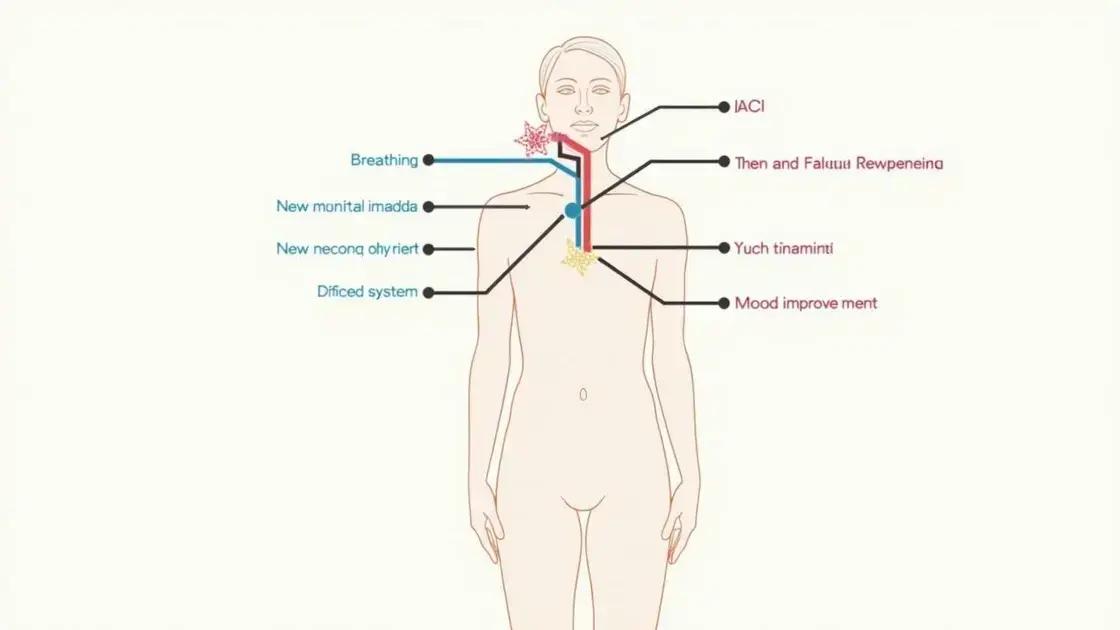Breathing techniques are effective methods for managing anxiety by promoting deep, controlled breathing to activate the body’s relaxation response. Techniques such as diaphragmatic breathing, 4-7-8 breathing, and box breathing can be easily incorporated into daily life, helping to reduce stress and improve overall well-being.
Anxiety can feel overwhelming, but managing it through proper techniques can lead to a more balanced life. Breathing techniques are proven methods for reducing stress and anxiety. In this blog post, we explore how to manage anxiety through breathing techniques, focusing on effective exercises and practical tips to incorporate them into your daily routine. With the right strategies, achieving a state of calm is within your reach.
Understanding Anxiety and Its Effects

Anxiety is a common emotion that everyone experiences from time to time. It is our body’s response to stress and can help us stay alert and focused. However, when anxiety becomes overwhelming or persistent, it can affect our daily lives and overall well-being.
Understanding Anxiety
Anxiety can manifest in various forms, including generalized anxiety disorder, panic disorder, and social anxiety. Each type has its signs and symptoms, which may include excessive worry, restlessness, fatigue, and difficulty concentrating. Recognizing these indicators is the first step toward effective management.
The Effects of Anxiety
Anxiety can have significant effects on both mental and physical health. It can lead to feelings of isolation, irritability, and difficulty functioning in social or professional settings. On a physical level, anxiety can cause symptoms such as increased heart rate, sweating, and muscle tension.
Long-term Impact
Chronic anxiety can contribute to various health issues, including depression, digestive problems, and cardiovascular diseases. It can also lead to unhealthy coping mechanisms, such as substance abuse or avoidance behaviors, making it essential to address anxiety early and effectively.
Emotional Impact
The emotional effects of anxiety can be profound. Those affected may feel a sense of loss or frustration due to their struggles. It’s crucial to understand that they are not alone and that support is available. Various strategies, including breathing techniques, can help manage anxiety symptoms and restore a sense of calm.
The Science Behind Breathing Techniques

Breathing techniques are not just about inhaling and exhaling; they involve a science that helps our body respond better to stress and anxiety. When we breathe deeply, our body begins a process that can lower heart rate and reduce muscle tension.
The Connection Between Breath and the Nervous System
Our breath has a direct link to the autonomic nervous system, which controls involuntary body functions like heart rate and digestion. There are two main systems: the sympathetic and the parasympathetic. The sympathetic system makes us alert, while the parasympathetic system relaxes us.
How Deep Breathing Affects Mood
Deep breathing activates the parasympathetic nervous system. This can lead to feelings of calmness and clarity. Research shows that slow, controlled breathing reduces the production of stress hormones. Hence, when we practice breathing techniques, we can effectively manage feelings of anxiety.
Physiological Benefits
Studies have shown that deep breathing can improve lung capacity and oxygen intake. More oxygen in the body means better functioning of organs and tissues, enhancing overall wellness. Lowering stress also aids in reducing inflammation, which can have long-term health benefits.
Mindfulness and Breathing
Incorporating mindfulness into breathing exercises can amplify their effects. When we focus on our breath, we anchor ourselves in the present moment, decreasing anxiety about future events. This practice can lead to improved mental health and resilience.
Practical Breathing Exercises to Try

Practicing breathing exercises is an effective way to manage anxiety. Here are some practical techniques you can try anywhere, anytime.
1. Diaphragmatic Breathing
This technique helps engage the diaphragm, promoting deep, effective breaths. To do this:
- Find a comfortable position, either sitting or lying down.
- Place one hand on your chest and the other on your belly.
- Breathe in slowly through your nose, allowing your belly to push out against your hand.
- Exhale through your mouth, feeling your belly fall.
- Repeat for 5-10 minutes.
2. 4-7-8 Breathing
This method helps calm the mind and body. Here’s how to do it:
- Inhale through your nose for a count of 4.
- Hold your breath for a count of 7.
- Exhale slowly through your mouth for a count of 8.
- Repeat this cycle 4-5 times.
3. Box Breathing
Box breathing enhances focus and reduces anxiety. Follow these steps:
- Breathe in through your nose for a count of 4.
- Hold your breath for a count of 4.
- Exhale slowly through your mouth for a count of 4.
- Hold your breath again for a count of 4.
- Continue this pattern for several minutes.
4. Equal Breathing
Equal breathing balances and harmonizes your body. To practice:
- Inhale through your nose for a count of 5.
- Exhale through your nose for a count of 5.
- Keep your breath steady and smooth.
- Practice this for 5-10 minutes.
These exercises are simple and can fit into your daily routine. Find the ones that work best for you, and gradually incorporate them into your life to help manage anxiety.
Tips for Incorporating Techniques into Daily Life

Incorporating breathing techniques into your daily life can significantly improve your ability to manage anxiety. Here are some practical tips to help you get started:
Create a Routine
Set aside specific times each day to practice your breathing exercises. Morning and night are great times to establish this routine. Even just 5-10 minutes can make a difference.
Use Reminders
To help you remember to practice, set reminders on your phone or place sticky notes in visible places. This will help you stay consistent with your breathing exercises.
Combine with Other Activities
You can integrate breathing techniques into other daily activities. For example, practice deep breathing while commuting, waiting in line, or taking breaks during work. This helps you stay mindful and relaxed throughout the day.
Practice Mindfulness
Incorporate mindfulness into your breathing exercises. Focus on your breath and the sensations in your body. This practice can enhance the benefits of breathing techniques and help keep anxious thoughts at bay.
Be Patient
It may take time to notice significant changes in your anxiety levels. Be patient with yourself and keep practicing. As you build this habit, you will likely find greater peace and control over your anxiety.
By making breathing techniques a part of your daily life, you can cultivate a greater sense of calm and resilience against anxiety.
Incorporating Breathing Techniques into Your Life
Breathing techniques can be a powerful tool for managing anxiety. By understanding how anxiety affects your body and mind, and utilizing the science behind breathing exercises, you can foster a sense of calm in your daily life.
Practicing various breathing exercises regularly helps improve your mental clarity and overall well-being. Incorporating these techniques into your routine, whether through creating a schedule or using reminders, can enhance their effectiveness.
As you make these practices a habit, you’ll find that you are better equipped to handle stress and anxiety. Remember, progress takes time, so be patient with yourself as you adopt these beneficial practices.
Ultimately, the journey to managing anxiety through breathing techniques can lead to a more peaceful and balanced life.
FAQ – Frequently Asked Questions about Managing Anxiety Through Breathing Techniques
What are breathing techniques?
Breathing techniques are exercises designed to promote deep, controlled breathing to reduce anxiety and stress levels.
How can breathing techniques help with anxiety?
These techniques activate the body’s relaxation response, reducing stress hormones and promoting feelings of calm and clarity.
How often should I practice breathing exercises?
It is beneficial to practice daily. Setting aside time for 5-10 minutes of breathing exercises can lead to positive results over time.
Can I do breathing exercises anywhere?
Yes, breathing exercises can be practiced anywhere, whether at home, work, or while commuting—it’s a flexible method to manage anxiety.
What if I don’t see immediate results?
It’s important to be patient and consistent. Progress may take time, and regular practice increases effectiveness.
Are there specific breathing exercises I should try?
Popular techniques include diaphragmatic breathing, 4-7-8 breathing, box breathing, and equal breathing. You can try different ones to see which works best for you.












